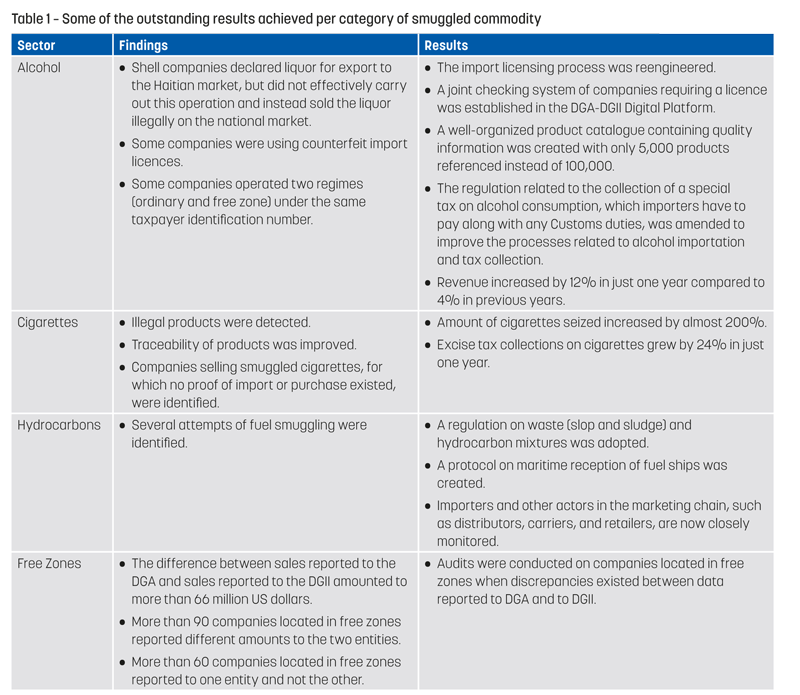Evolution of data analysis at Dominican Customs
22 June 2020
By Carlos Canelo Cohen, Database Specialist, Strategic Planning and Economic Research Management, General Directorate of Customs, Dominican RepublicTalking about competitiveness, effectiveness, quality control, risk management, and compliance is meaningless if we do not talk as well about access to technology and data analysis tools, including the need for trained personnel who are able to develop and manage these very tools.
At the General Directorate of Customs (DGA) of the Dominican Republic, data analysis, and data-driven decision making used to be labelled as “difficult and unattainable.” This pessimism was well-founded. Limitations existed in terms of technological infrastructure, connectivity between IT systems, access to data, and data quality, to name a few. The situation reinforced the prevailing culture and status quo. Performing analyses and providing results in a timely manner was not only difficult, but also did not receive the support it should have.
However, the DGA’s Department of Economic Analysis, recalling the phrase coined by Voltaire “perfect is the enemy of good,” had demonstrated that Customs had the necessary elements to initiate data analysis, namely the purpose, the data, and the analysts.
In August 2016, when new management took over, the DGA began a process of change, which affected all areas of the organization. At the core of this process was the investment in training as well as a human resource reshuffle in order to have the right people in the right positions.
As part of the change, Dominican Customs endeavoured to create the necessary conditions to leverage and exploit the large amount of data available inside and outside the institution.
Purpose
Every organization needs a purpose, a well-defined north, a shared vision capable of igniting the spark and keeping the organization moving. The five general objectives of the DGA Strategic Plan state that Customs must:
- Facilitate foreign trade.
- Collect and manage revenue efficiently.
- Strengthen the institution.
- Ensure quality services.
- Implement comprehensive risk management.
“Few human forces are as powerful as a shared vision.” Peter Senge, an American systems scientist
Data and data analysts
To develop data analysis capacity, the DGA decided to put together a team and to look for potential candidates within its various services. The team was multidisciplinary and included staff working in IT, statistics, and economics.
Regarding data, although the institution did not have a “data warehouse,” a cleaned, organized, and updated database recording import and export transactions had been built and maintained by the Statistics Department. With the help of statistics staff, a data warehouse was built with clean import and export information. Another challenge was the construction of a database recording a breakdown of revenue collections by tariff code and by type of revenue (administration fees, VAT, fees related to laboratory work, etc.); basic, but vital information.
Although the DGA and the General Directorate of Internal Revenue (DGII) are two arms of the Tax Administration, their IT systems were not connected. To overcome this, a rather rudimentary, but effective mechanism was used to exchange information. It consisted of establishing direct communication with a counterpart department in DGII and copying large data tables onto pen drives (USBs).
I remember taking a taxi on a regular basis to DGII Headquarters with a pen drive in my pocket to get the information that I needed because the data tables were too large to be sent via email. Then, I would head back to my office and export the tables to SQL with my cell phone in one hand talking to the guys at DGII who understood the data, so that I could actually use it and crossmatch it with my tables, and thereafter validate that everything was good.
 Institutional results
Institutional results
With a clear purpose, a commitment from critical entities to exchange information with the DGA, a more reliable database, trained analysts, and the support of our institution, the team started analysing data and obtained excellent results.
An exemplary collaboration is now in place with DGII, with whom the DGA exchange live data and maintain active working groups. Officers from the Customs Intelligence, Post-Audit, and Free Zones Units as well as advisors to the Director General also benefit from this exchange of information and attend meetings of the working groups.
Thanks to this exchange of information, the DGA managed to:
- improve taxpayer profiles (economic activity, performance, etc.) for intelligence and post-audit control;
- identify taxpayers who reported different figures to the DGA and DGII in terms of value and quantity of sales on the local market and/or the value and quantity of goods purchased abroad;
- validate the payment of import taxes and motor vehicle licence fees;
- identify assets and real estate of taxpayers who were found guilty of fraud by the DGA.
Some of the results achieved are further listed in table 1 below and illustrated in the graphics accompanying this article.
Project evolution
The results achieved were highly valued by the DGA’s new leadership team, which took up the reins in 2016, favouring support for further efforts to be deployed when it comes to data analysis.
Following an agreement with DGII, the DGA’s Sub-Directorate of Technology developed a data exchange model in line with the requirements of both DGII and the National Investigations Department (DNI), an entity which reports to the President of the Dominican Republic.
Back in 2015, the DGA’s data analysis team had already developed tools, using Power BI, a business analytics service by Microsoft available under a free licence, which enables end-users to create their own reports and dashboards. This enabled the team to demonstrate the value of such tools to the DGA management team and to argue for the purchase of a professional licence or any other similar service.
The DGA’s IT Director helped the team to select the right solution on the market. As the team knew where it was heading and what it wanted, the selection process was efficient, and straightforward. In November 2017, the DGA finally acquired a data analysis platform developed by a commercial company. When the team started using the platform, it was like unleashing children in a big playground.
After receiving basic training on how to use the platform to develop its own tools, the DGA created several applications to deal with specific issues such as Finance, Express Mail, Vehicles, Intelligence, Inspection, Free Zones, Audit, and Inspection. These applications enabled the DGA to replace manual reports, automating them, and reducing the time and costs associated with their development. They also allow information to be disseminated at all levels of the institution in an efficient, safe, and dynamic way.
One of the main goals of the applications is to help staff understand and leverage their data. Managers, administrators, and officers can now easily view and monitor real-time risk indicators and operations from their mobile devices, tablets, or computers. Being better informed, they can make sounder decisions and explain them.
Currently, the data analysis team is working on the automation of the Time Release Study (TRS). A first TRS was carried out according to the guide provided by the WCO and in coordination with the two main ports of the Dominican Republic: Haina International Terminals (HIT), and DP World CAUCEDO. Preliminary results have already led to important decisions, which were swiftly implemented, contributing to an improvement in the goods clearance process.
The TRS also enabled the team to identify critical data collected by the Port Authority, which was not being captured in the DGA system before, or, if captured, was not reliable. The team is now working on the development of risk indicators based on this new data. These efforts, together with other developments in other areas of the institution, enabled the DGA to base all decisions on sound data analysis, to improve the implemented processes, and to undertake performance measurement.
Next steps
In 2020, the data analysis team intends to develop three important applications that will have a major impact on Customs processes and decision making. They will deal respectively with mirror data analysis, price analysis, and fraud detection.
To analyse data, the team will be using the methods and algorithms developed by the WCO BACUDA team. This requires the team to learn how to employ R, Phyton, Machine Learning, and Web Scraping tools, something the team is currently busy doing. There is also a need to improve data governance, making sure that data is unified, consistent, accurate, and complete, thereby eliminating duplicate data and data management tasks.
The team’s ambition is to introduce the concept of business intelligence into the DGA. Business intelligence is the collection of strategies and tools that are used to analyse business information. To do so, the DGA will put together a Business Intelligence Department.
“If you can’t measure it, you can’t improve it.”
Peter Drucker, an Austrian-born American management consultant, educator, and author
At present, the multidisciplinary team of mathematicians, statisticians, economists, and systems engineers working on data analysis is dispersed in several areas of the institution. Gathering these professionals under the same roof will facilitate the development of tools, systems, and methods to further analyse and disseminate information within the organization, a process that is continuous in nature.
Recommendations for Customs
Before concluding, I would like to make a few remarks. I believe that to move staff in charge of data analysis forward one needs to:
- stop complaining, and make good use of what one already has;
- get management on one’s side, and once this is achieved, the rest of the institution will follow;
- produce actual results as there is no better way to get management support;
- define the purpose, collect data, and identify the right people for the job;
- finish what one has started.
In addition, it should be remembered that data analysis is an ongoing process that needs to be readjusted to the same extent that the institution and business rules change. The goal pursued is to generate knowledge through the analysis of available information, in order to strengthen the foundation of decision making, redefine working practices and risk criteria, ultimately positioning ourselves as modern Customs administrations that integrate continuous improvements into its processes.
More information
c.canelo@aduanas.gob.do
www.aduanas.gob.do


